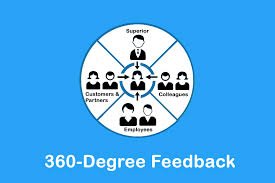Feedback is essential for the growth and development of any organization. Whether you’re an employee looking to improve your performance or a manager striving to create a positive workplace environment, feedback plays a crucial role. One of the most effective feedback tools available today is 360-degree feedback. This method provides a comprehensive view of an individual’s strengths and weaknesses, allowing for a more holistic approach to personal and professional development. But what exactly is 360-degree feedback, and how can it benefit your organization? Let’s explore in detail.
What is 360-Degree Feedback?
360-degree feedback is a performance evaluation system where employees receive feedback from a variety of sources. Instead of only receiving feedback from their direct supervisors, employees gather insights from peers, subordinates, and even themselves. This multi-source feedback approach helps create a well-rounded perspective on an individual’s skills, behavior, and performance.
The process typically involves a combination of self-assessment and external feedback. Employees reflect on their own performance, while colleagues, managers, and direct reports offer their opinions on various competencies. The result is a broader, more objective evaluation of an individual’s capabilities, which can provide valuable insights into areas that require improvement or further development.
How Does 360-Degree Feedback Work?
The 360-degree feedback process is generally structured in several key stages:
- Preparation: Before the feedback process begins, organizations usually define the competencies and behaviors they want to assess. These might include areas such as communication skills, teamwork, leadership qualities, problem-solving abilities, and more.
- Survey Distribution: Employees are asked to complete a feedback survey, providing insights into the performance and behavior of their colleagues. These surveys are typically confidential to ensure honest and unbiased feedback.
- Feedback Collection: After collecting all the feedback, the data is analyzed to create a comprehensive report for each individual. This report consolidates feedback from all sources, identifying patterns and offering insights into both strengths and areas for growth.
- Feedback Delivery: The feedback report is shared with the individual being evaluated. It’s important to provide constructive feedback in a supportive manner to ensure that the individual feels motivated to work on any areas of improvement.
- Action Plan: Once the feedback is delivered, employees can develop an action plan based on the insights they have received. This might include setting personal development goals, improving specific skills, or taking part in additional training programs.
Benefits of 360-Degree Feedback
360-degree feedback offers several advantages that can significantly enhance an organization’s performance and culture:
- Holistic View: Since feedback comes from various sources, it provides a comprehensive view of an individual’s performance. This eliminates the bias that may come from relying solely on the feedback of a single person, such as a supervisor.
- Improved Self-Awareness: Employees gain a better understanding of their strengths and weaknesses through feedback from multiple perspectives. This self-awareness is crucial for personal growth and can lead to improved job satisfaction.
- Enhanced Teamwork: With feedback from peers and subordinates, employees are more likely to recognize how their actions impact the team. This can foster collaboration, increase empathy, and improve overall teamwork.
- Better Performance: By identifying areas for improvement, employees can focus on developing skills that will make them more effective in their roles. This leads to better individual performance, which in turn boosts organizational performance.
- Leadership Development: 360-degree feedback is particularly valuable for developing leadership skills. Managers and executives can gain valuable insights into their leadership style and how it’s perceived by others. This feedback helps leaders refine their skills and build stronger relationships with their teams.
Challenges of 360-Degree Feedback
While 360-degree feedback offers many benefits, it’s not without its challenges. For one, it can be time-consuming and complex to manage, especially in large organizations. Additionally, employees may feel uncomfortable receiving feedback from their peers or subordinates, especially if the feedback is critical.
Another potential issue is the risk of feedback being too generalized or vague. It’s essential to ensure that the feedback provided is specific, actionable, and focused on behaviors rather than personal characteristics. Without clear and constructive feedback, the process may lose its effectiveness.
Best Practices for Implementing 360-Degree Feedback
To make the most of 360-degree feedback, organizations should follow certain best practices:
- Clarify Objectives: Clearly define the purpose of the feedback process and communicate its importance to employees. Ensure everyone understands how the feedback will be used and how it will contribute to their professional development.
- Maintain Confidentiality: Protect the anonymity of those providing feedback to encourage honest and open responses.
- Focus on Development, Not Judgment: The goal of 360-degree feedback is to help individuals grow and improve. Avoid using the feedback as a tool for performance appraisals or disciplinary actions.
- Provide Support: Offer training and coaching to employees who may need help interpreting their feedback and creating an action plan.
Conclusion
360-degree feedback is a powerful tool that can drive personal and professional growth for employees and help create a more engaged, effective, and collaborative workplace. By providing a balanced and comprehensive view of an individual’s performance, it helps organizations identify strengths, highlight areas for improvement, and ultimately enhance their workforce’s performance.
To get started with the 360-degree feedback process and learn more about how it can benefit your organization, visit the 360 degree feedback.






